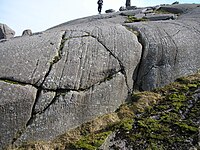Structure (geology)
In geology, the structure is the spatial position and arrangement of rocks and rock components. It includes the formation of the rock-forming minerals ( grain structure ) as well as the rock as a whole and its connection with other rocks ( large structure ). Typical structural elements include grain size and shape , stratification , foliation or fissures .
Structural science is used to record, map and evaluate structural features. Their evaluation allows conclusions to be drawn about the formation of a rock ( petrogenesis ) and the processes involved. In mining or in engineering-geological , hydrogeological or mineral-geological applications, structural analysis is an important basis for planning and implementing measures.
Grain structure
The grain structure of a rock is examined microscopically on thin sections in petrography . The individual grains or phases are described, ie the individual minerals and other components of a rock .
Grain structure features are:
- spatial arrangement and orientation ( texture )
- absolute and relative grain size, shape and mutual delimitation of the grains ( structure )
- other characteristics.
See also the article grain structure
Large structure
The large structure describes spatial observations from the handpiece of a rock to the geological profile . It can be described as a surface structure or as a linear structure on fold axes at layer boundaries, crevices and faults .
With a structure compass , the spatial position of a layer or other planar or linear geological structures are measured in one work step.
Primary and secondary structure
The “primary structure” of a rock or a geological structure is created through its formation (e.g. the grain structure through crystallization or stratification through sedimentation ). Subsequent events (e.g. tectonics ) change structural properties and leave behind a "secondary structure".
Examples
Is the age-deposition sequence unclear (normal or tilts) of a rock complex can Geopetalgefüge for determining the storage are used.
See also
swell
- Hans Murawski, Wilhelm Meyer: Geological dictionary . 11., revised. and exp. Edition. Elsevier, Spektrum, Akademischer Verlag, Munich 2004, ISBN 3-8274-1445-8 .
- Rudolf Hohl (ed.): The history of the development of the earth . 6th edition. Werner Dausien Verlag, Hanau 1985, ISBN 3-7684-6526-8 , p. 97 f .
